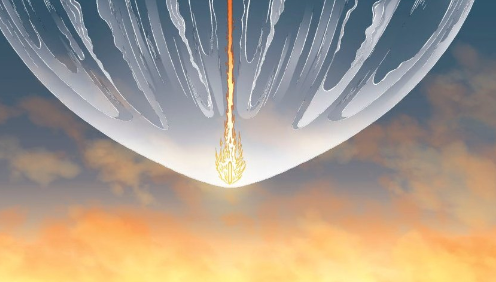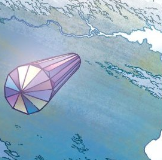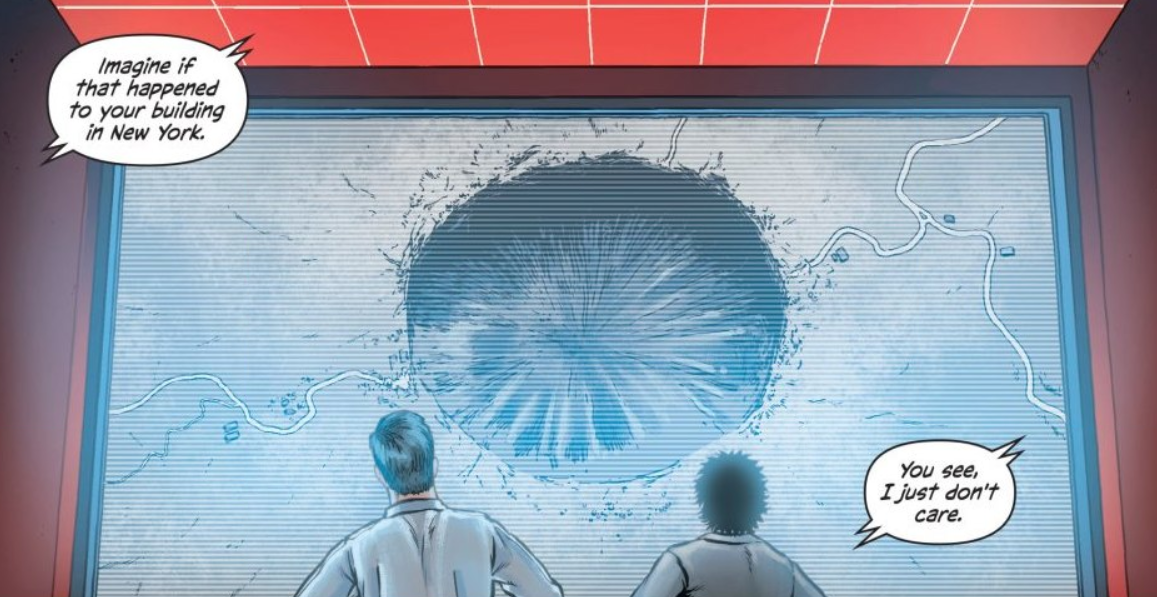For being telling such a technologically advanced story, in DC’s The Wild Storm, the characters occasionally like to go very old school. In this case, it was an example of “when someone bothers you, drop something on them.”
Something that won’t break.
From very high up.
Okay – setting the stage then, in issue #15 of The Wild Storm, Skywatch and IO are dancing around starting a war with one another. Skywatch, as the name suggests, is located in an orbiting satellite, while International Operations (IO) is based on earth. A third group, a “wild” Covert Action Team is fighting against both…covertly. Long and the short, the WildCATs hit Skywatch through an IO asset. Skywatch blamed IO, and Skywatch’s leader, Henry Bendix, swore revenge.
Specifically, Bendix told his assistant, Lauren Pennington, that he wanted to drop “Little Stick” on the IO facility. As Bendix explained to Pennington:
“We were playing with it in the eighties. It’s a diamond rod about a foot long. Radar Invisible. We literally drop LIttle Stick. Drop it into the atmosphere. As it drops, it gets hotter and hotter, builds up more and more energy. And lands like a meteorite strike. Like a tac-nuke. No radiation. Just pollution and heat and shockwave and a big hole.”
Henry Bendix is crazy in a glorious way, and the entire 24-issue series so far has been an amazing tour-de-force by Warren Ellis and Jon Davis-Hunt. Calling it the best paranoid speculative science fiction you’ll read shortchanges it on so many levels because it’s so much more. But it’s so good. You should check it out. Every issue, every page, every panel is smart, tech-savvy goodness that practically is screaming to be made into the next “it” show on HBO. Seriously – it’s so good.
So anyway…if you – a pop culture aficionado – find yourself thinking that Bendix’s plan sounds familiar, you’re more right than wrong. The idea has been used here and there, and perhaps got its biggest chance to shine in 2013’s G.I. Joe Retaliation, as Cobra’s Project Zeus. From low earth orbit, the bad guys dropped a tungsten rod on London, effectively destroying a large portion of the city. Before you go scrambling for that scene, it was more than a little wonky. Just be aware. Oh, and Ellis has mentioned the idea before in his terrific series Global Frequency.
The coolest things about Bendix, and Cobra’s plan years before? In theory, it works, and in…theory(?) its a real plan that’s been under consideration by the U.S. military.
So let’s talk about the science of kinetic bombardment.
Dropping Things from Space
Before we start into the science of this, let’s be clear – this is planned, targeted dropping of shaped objects from earth orbit. This isn’t “dropping rocks from space” as has been seen in many science fiction novels over the years – John Scalzi has used it in his Old Man’s War series, and it showed up in Nemesis Games, the fifth novel in The Expanse series just to name a couple. That approach is just shove a big enough rock at your target and it will cause the damage, destruction and death you’re looking for to destabilize your enemy. That’s all well and good but sometimes, you want to use a scalpel instead of a chainsaw
What Bendix did with Little Stick was focused – one specific, non-nuclear weapon dropped from space to destroy one specific target, with limited side issues. And its origin can be traced back to the 1950s.
Back then, Jerry Pournelle (yes, the same one who went on to write with Larry Niven, as well as a number of his own science fiction and military science fiction stories) was working as a Boeing Operations researcher. Pournelle had an idea – a simple idea based in the extinction of the dinosaurs: drop something tough from space. The “something” would be tungsten rods the size of telephone polls. Tungsten was selected due to several of its physical properties, including its density and its high melting point, the highest of the metals on the periodic table.
Depending upon their mass and the height from which they were dropped, the rods would strike targets with enough energy to wipe out a surface installation or even penetrate a bunker. Pournelle called his idea Project Thor, and the nickname “rods from God” also caught on. In more science-y terms, the idea falls into the category of a kinetic energy projectile – a relatively “dumb” object that is very dense and moves very fast. Given that combination, little can stand in its way. It’s the same as the idea behind trebuchets or catapults – just a higher drop and a denser projectile.
The U.S. military is looking at working with the idea – although not dropping things from the sky like Bendix, but rather, firing extremely dense projectiles horizontally at extremely high speeds via technology such as a rail gun. Using only electromagnetism to accelerate the projectile, railgun “bullets” can reach speeds upward of Mach 6, six times the speed of sound.
It’s doubtful (or highly classified) that the military is looking at something like Project Thor currently, though. Chief among the reasons – it takes a lot of energy to get something into space. While programs such as Space X and others are bringing those costs down, but still – NASA gives a ballpark price at $10,000 per pound.
If we use a standard telephone pole size for our tungsten rod (30 feet tall, 10 inches wide), and calculate its volume (volume of a cylinder = πr2h – and convert our measurements to metric) we get around 463,131 cm3 The density of tungsten is about 19.3 g/cm3, so if we rewrite the density formula to solve for mass:
mass = density x volume
Mass = (19.3)(463,131)
Mass = 47538428.3 grams, or…
Mass = 47,538.4 kg, which is about 104,894 pounds.
Ballparking the price to get one tungsten rod into space, multiply the pounds by $10,000, and we get $1,048,940,000 per rod. And you’re probably going to want more than one. You might have more than one enemy. Or need to hit one enemy more than once.
Two things – you could argue that the military probably gets a discount. They probably do. Maybe. Still. That’s a billion dollars per rod, pre discount. Also, you could argue that they could just capture an asteroid and make the rods in space. Great idea – we’re not there yet.
So I dig Bendix’s Little Stick, made from carbon, one of the most abundant elements in our neighborhood. Yes, he is living on a futuristic, science fiction satellite headquarters – so on-site manufacture might not be prohibitive. All he needs to make diamond Little Sticks is carbon. Where could he get that? He’s got a staff, a crew – just collect their exhalations…or other stuff. Pull the carbon from the carbon dioxide, send the oxygen back into the atmosphere, keep the carbon, turn it into a diamond.
If you’re Henry Bendix, diamond acquisition and/or manufacture isn’t going to slow you down.
Dropping Little Stick
So let’s run some numbers on Bendix’s Little Stick.
Stop snickering.
In the comic, Bendix says the diamond rod is “about a foot long.” When we see it in the comic, it looks to be a twelve-sided rod with pointed ends. For simplicity’s sake, I’m going to toss the complex geometry in exchange for a cylinder, made of diamond that’s a foot long.
This is a conservation of energy problem at its heart. That means that when the Little Stick is above the earth, it has gravitational potential energy, or energy of position. As it falls, its gravitational potential energy decreases and its kinetic energy, the energy of motion, increases. The Law of Conservation of Energy tells us that in a closed system, the total amount of energy must remain constant, which in our case means that the gravitational potential energy Little Stick has prior to its drop is the same as its kinetic energy just before impact.
Okay, the example in the comic isn’t a closed system. Little Stick interacts with the atmosphere on its way down, and will lose some of its energy, which will slow it down. Given that I want to keep this as “entry-level physics” as I can, we’re going to ignore air resistance and Little Stick’s interaction with the atmosphere right now, although we’ll come back to it later.
That said, the only formula we’ll need is that to calculate the gravitational potential energy of Little Stick, which is:
EP = mass x gravity x height
Gravity will be 9.8 m/s2, but what about mass and height? For height, I’m not sure what altitude Skywatch’s satellite headquarters is at, but I’m going to guess it’s geostationary, which means that it has a fixed altitude of 35,786 km. As always, if you’re not a fan of my numbers, use your own and give the calculation a try. I’m going with geosynchronous because it gives a lot of height compared to something in low earth orbit, like the ISS, which orbits at about 400 km.
As for the mass of Little Stick – that’s easy enough. It’s made of diamond and we’re saying it’s a cylinder. Again, the formula for the volume of a cylinder is:
Volume = πr2h
And the density of diamond is 3.5 g/cm3.
Little Stick looks pretty slender, so its diameter isn’t going to be that close to its hieght, which would fatten it. I’m going to say the diameter is 6 inches.
Let’s make sure we have all of our numbers with the correct units…
Diameter: 6” = 15.24 cm
Radius = ½ diameter = 7.62 cm
Length = 12” = 30.48 cm
Height = 35,786 km = 35,786,000 m
Little Stick’s volume:
Volume = π(7.62)2(30.48)
Volume = 5560 cm3
Density = mass/volume (rearrange to solve for mass)
Mass = volume x density
Mass = (5560)(3.5)
Mass = 19,460 g, or 19.5 kg
Let’s take Little Stick up to geosynchronous orbit height and figure out its energy:
EP = mass x gravity x height
EP = (19.5)(9.8)(35,786,000)
EP = 6,688,500,000 Joules, or
EP = 6.7 x 109 J or 6.7 gigajoules
First things first, that’s a fair amount of energy. The energy released by one ton of TNT is equal to about 4.18 x 109 J, so we’re looking at the destructive power of just over one and a half tons of TNT. That’s a pretty small amount of firepower in terms of nuclear weapons – the atomic bomb dropped on Hiroshima was equivalent to 15,000 tons of TNT. A single Tomahawk cruise missile, which are used by the U.S. military to take out building-sized targets, has the destructive power of about half a ton of TNT, so Little Stick, roughly, did about three cruise missiles’ worth of damage to the IO site.
Obviously, this would be much smaller, but still – probably just enough to do what Bendix needed it to do – send a message. It’s unclear from the comic if Little Stick took out the entire installation, or just the core, but that foot-long, just about 20kg stick of diamond would certainly do a job on whatever it hit. Probably not as much as what was shown, but if it hit a building, it wouldn’t be left standing.
A Few Considerations
Little Stick was hot coming in. Two things about that. First, diamonds can burn up to carbon dioxide. Given enough heat and enough oxygen, diamonds will burning away into smoke. The demonstration is still done today, and was performed by the father of modern chemistry, Frenchman Antoine Lavoisier. The fact that he did it during the French Revolution, and it was seen as a show of the extravagances of the rich, and he’d made some enemies all contributed to Lavoisier losing his head at the guillotine. Modern demonstrations of burning diamonds are performed in present-day chemistry courses without any decapitations.
Bendix’s Little Stick was shown to be extremely hot as it came in towards its target. Why didn’t it burn?
Not enough oxygen in the atmosphere.
Burning diamonds needs oxygen, but it can’t be done unless you provide excess oxygen to the fire. Blow pure oxygen on the fire, and your diamond will be gone in a wink.
Speaking of the heat – while we’re not going to worry about how much energy Little Stick lost to heating up the air around it, I do want to make sure we’re clear on why it was hot. As has been show in countless movies, television shows and other stuff, things entering the atmosphere heat up to be red hot.
Repeat after me: it’s not due to friction.
The heat generated by returning space capsules or incoming asteroids comes from the layer of air in front of the object not being able to get out of the way fast enough. Instead of moving, the layer of air is compressed between the object and the air in front of it. Compress air, and it heats up. Touch the air pump the next time you pump up a bike tire or a basketball. That’s compressing the air inside, and the heat rapidly moves to the metal or plastic of the pump, warming it up.
So Little Stick came in hot – most likely very hot. What would that do, in terms of its destructive power? If it was hot enough, Little Stick would heat up the air coming in, and the heat could then move through the air and set buildings and other materials on fire. Little Stick was hot and its energy most dissipated as heat – which probably turned Little Stick from a diamond back into graphite, which happens when you heat up diamonds to ridiculous temperatures without any increase in oxygen.
After the impact, the shockwave and the leftover heat would do the most damage to the site.
How fast did Little Stick come in?
This is a conservation of energy problem, so the total gravitational potential energy at the drop height equals the kinetic energy at the moment just before impact. Let’s see what that means for its speed:
Ek = ½ mv2 – solve the formula for velocity, v
v = sqrt(2Ek/m)
v = 26214.1 m/s
The speed of sound is about 343 m/s, which is one “Mach,” therefore Little Stick is coming in at about 76 times the speed of sound, putting it into the hypervelocity range. In terms of human reaction time, one second, the IO facility was standing there, the next, there was an explosion. There’d be no way to see Little Stick come in.
One Issue…
Yes, this is a comic book which is playing somewhat fast and loose with the science, so you may have more than one issue with the scene, but my issue is the panel that shows Little Stick coming in at oblique angle relative to the earth’s surface. The next panel shows it perpendicular to the surface of the earth. Little Stick is just a small rock that was dropped. A shiny, pretty rock, but still a rock. A rock that somehow changed its trajectory. Given the wind/atmosphere pushing against it, and it’s initial angle, it would’ve needed some kind of guidance to come in right on target.
Space capsules end up coming in perpendicular to the ground thanks to gravity pulling on the capsule and the drag from the parachute. SpaceX rockets come back in and land upright due to maneuvering thrusters.
Little Stick? Nothing. But somehow it changed its direction coming in. If the Skywatch station was said to be in a geosynchronous orbit and the target happened to be directly under it, then…maybe. But the chances of the satellite “just happening” to be directly over the target? Really, really small.
Given the overall coolness of the scene and series…I can live with it.
I’m a STEM Teacher – How Can I Use This?
I use kinetic bombardment all the time with conservation of energy – I’ve used the G.I. Joe approach and others in terms of “Be a Better Supervillain.” A modified form of this wouldn’t be that bad for an exercise after a lab that illustrates the higher up an object is, the more energy it has when it hits. This is easily shown by dropping golf balls into flour from different heights and having students describe the craters that were made. See if there is a relationship between the diameter of the crater and the initial energy of the the ball. I’ve told students they were at a Cobra research station before, and must show a proof of concept and that the idea is scalable to deliver the energy that’s needed (minus air resistance of course).
I like the TNT equivalents as well. They can be found at many sites including the Wikipedia page linked above. I plan to start using those this year – asking for them in the work, but not helping them find them at all.
A challenge for my students would be to show them the scene from G.I. Joe Retaliation with some added information (the height of the platform mostly), and ask how much energy a rod would have when it hit. I’d also ask them to critique the physics of the scene too – as I mentioned above, there are more than a few instances of oddness in the scene (it rings like a bell when it hits?)
My more advanced students will get to worry about the air resistance and the heat produced.
Good luck!












